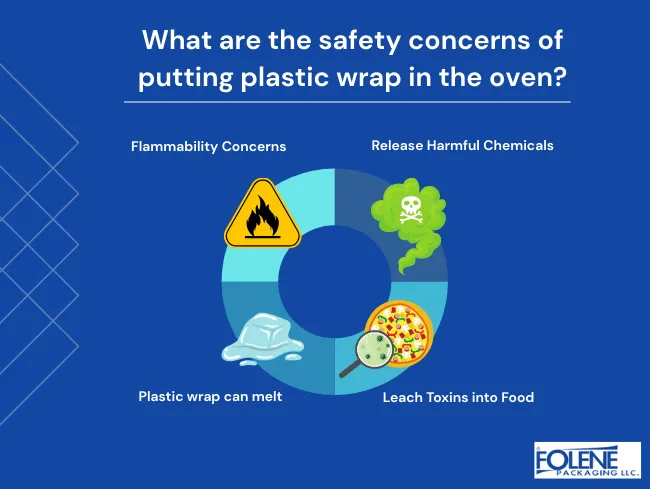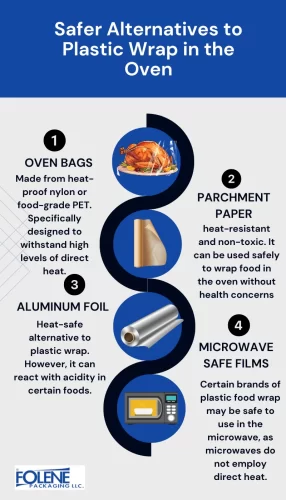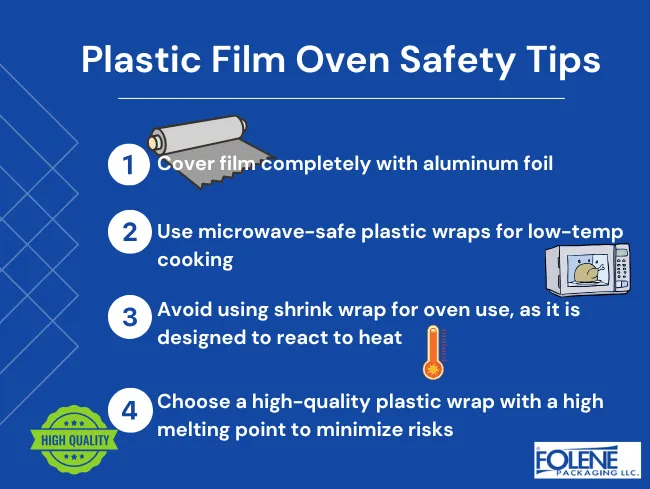Many chefs and cooking personalities showcase using plastic wrap as a “wonder method” that locks in moisture while cooking proteins. But can you put plastic wrap in the oven safely? Folene Packaging explores the safety concerns of this cooking method and some safer alternatives to try instead.
Traditional household plastic wrap, also known as cling film or saran wrap, is a thin plastic film used to seal and secure food items in containers. Most of these wraps are currently made from low-density polyethylene (LDPE). LDPE is part of the Polyolefin family and is considered a safer alternative to PVC (polyvinylidene chloride) film- the original Saran wrap material invented in 1933 by Ralph Wiley at Dow Chemical, initially developed as a spray to protect fighter planes from salty sea spray. Plastic wrap is not designed for high-heat cooking and can release harmful chemicals when heated.
What is Plastic Wrap and Its Oven Safety Concerns
Plastic wrap, also known as cling film or saran wrap, is a thin plastic film commonly used for sealing and securing food items in containers to keep them fresh. However, when it comes to using plastic wrap in the oven, safety concerns arise. Most plastic wraps are not designed for oven use, and manufacturers like Saran Wrap, Glad, and Stretch-Tite warn against it.
The main concern is that plastic wrap can release harmful chemicals into food when heated. These chemicals can leach into the food before the plastic wrap even melts, posing a risk to human health. Additionally, plastic wrap can melt and stick to the food, making it difficult to remove and potentially causing a mess.
Another issue is that plastic wrap can catch fire or release toxic fumes when exposed to direct heat. This is especially true for conventional ovens, toaster ovens, and stovetops, where the heat is more intense. Even if the plastic wrap doesn’t melt or catch fire, it can still release chemicals into the air, which can be harmful to breathe in.

To minimize the risks, some chefs and recipe makers cover the plastic wrap completely in aluminum foil, keep the temperatures low (ideally below 250°F), and use commercial-grade wrap. However, this method is not foolproof, and the risks of using plastic wrap in the oven are still present.
A safer alternative to plastic wrap in the oven is parchment paper or oven bags. These materials are heat-resistant and designed for oven use, making them a better choice for cooking hot food. Additionally, they don’t release harmful chemicals into the food, making them a healthier option.
Risks and Precautions of Using Plastic Wrap in the Oven
Most LDPE plastic wraps have a low melting point, generally between 220° and 250°F, making them unsuitable for oven use. Convention ovens, toaster ovens, and other sources of direct heat can shrink plastic wrap and release harmful chemicals. This is of particular concern when using plastic wrap on food, as some plastic wraps may contain phthalates, which can leach into food when heated.
Safe Alternatives to Plastic Wrap for Oven Use
Oven bags are a safe and simple alternative to plastic wrap for cooking. These are often made from heat-proof nylon or food-grade PET and are specifically designed to withstand high levels of direct heat without melting or leaching harmful chemicals into food.
Parchment paper is both heat-resistant and non-toxic. It can be used safely to wrap food in the oven without health concerns.
Aluminum foil is a popular heat-safe alternative to plastic wrap. However, it can react with acidity in certain foods.
Certain brands of plastic food wrap may be safe to use in the microwave, as microwaves do not employ direct heat. However, it is essential to always check the manufacturer’s instructions and follow them closely for optimal results.

Best Practices for Oven Safety with Plastic Wraps
Several chefs tout the benefits of using plastic wrap for cooking in the oven as a method that seals in moisture, but it is important to be aware of the risks associated with exposing plastic wrap to high temperatures. While most experts agree it is wise not to place most plastic wraps under direct heat in the oven, they do concur that it might not be as dangerous as most people assume with some precautions in place. If you decide to try this cooking method at home, follow these safety guidelines for using plastic wrap in the oven.
If you must use plastic wrap in the oven, cover it completely with aluminum foil to prevent exposing the film to direct heat. You’ll gain the moisture-locking benefit of the plastic wrap while the foil protects the film from
Use microwave-safe plastic wraps for low-temperature cooking, but always check the manufacturer’s instructions.
Avoid using shrink wrap for oven use, as it is designed to react to heat and can easily release chemicals or melt under high temperatures. Not recommended for use in conventional ovens, toaster ovens, or for boiling food.
Choose a high-quality plastic wrap with a high melting point to minimize the risk of chemical release.

Conclusion: Prioritizing Oven Safety
While some chefs and cooking show hosts use plastic wrap in the oven, it’s essential to prioritize oven safety and use alternative wrapping methods. Always check the manufacturer’s instructions and follow safe cooking practices to avoid releasing harmful chemicals into your food. You can ensure a safe and healthy cooking experience by choosing alternatives and following best practices.



